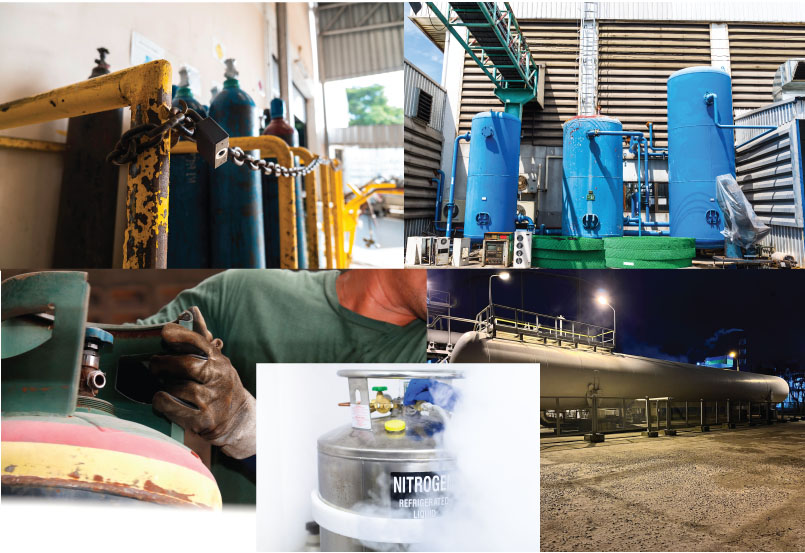
Used across a variety of industries and for multiple purposes, compressed air and gases are associated with various hazards. Although both are kept under high pressure, they take different forms. Compressed air is kept exclusively for the powering of mechanical devices such as pneumatic tools and compressed air systems. Compressed gases are typically kept in solid cylinders to be safely dispensed through a control valve.
Given the associated risks, we’ll focus on the safest storage and handling methods in this blog, specifying the signage that should be put in place for the maintenance of gas and air compressor safety.
Storing and Handling Compressed Air
Great care must be taken given the extreme pressure at which compressed air is stored. It’s important to carefully inspect any pneumatic tools, ensuring that they haven’t been damaged and are as safe as possible to use. Air hoses and fittings should be tightly secured and care taken when using such tools within close proximity of fuel, flammable vapours, or explosive atmospheres.
Air receivers should also be thoroughly tested, ensuring that the pressure level is within the maximum allowance. It should be possible to inspect the entire outside surface of any air tanks, ensuring that they remain easily accessible when in operation. It will also be necessary to check air distribution hoses before use, ensuring that they are in optimum condition and connected to pipe outlets. Blow-off valves should be shielded to limit the risk of personal injury and equipment damage.
There will be a risk of serious injury or death if the proper precautions aren’t taken when working with compressed air. Projected at a pressure of 40 pounds per square inch (psi), the air can cause chips and other particles to be dislodged and strike with extreme velocity. Such particles might even break through the skin and cause potentially dangerous air bubbles to form in the bloodstream. There is also a risk of hearing damage as compressed air can reach 120-130 decibels (dB).
These safety precautions should be taken in the handling of compressed air:
- Take and follow training specific to the use of compressed air systems
- Ensure that attached pipes, hoses and fittings correspond with the pressure rating
- Wear safety goggles, face guards, shields and other forms of personal protective equipment (PPE) as appropriate.
Storing and Handling Compressed Gas
Cylinders may be specifically designed for the containment of liquefied, non-liquefied, or dissolved gases. It is important to select the most suitable cylinders for the avoidance of potentially dangerous chemical reactions and corrosive effects. Such cylinders should also be appropriately labelled, indicating the contained gases and any associated hazards. It might be appropriate to attach labels highlighting the presence of GHS gases under pressure and warning of extreme flammability.
Gas cylinders should be kept in a well-ventilated area away from any heat sources to prevent ignition and explosion. You should also keep them upright and away from direct sunlight. It will be necessary to check for the correct use of fittings and connectors, referring to the manufacturer’s instructions or asking a qualified safety professional if in doubt. Such fittings and connectors must also be securely fastened for the prevention of gas leaks. Regular checks should be carried out and damaged or worn components replaced for the avoidance of gas leaks.
These safety precautions should be taken when handling gas cylinders:
- Wear gloves, eye protection and other forms of oil and gas PPE as specified by the safety data sheet (SDS) or product label
- Avoid the dragging and dropping of cylinders due to the risks of damage, gas leaks, and explosions
- Secure cylinders in an upright position, using a rack or stand
- Establish the compatibility of contained gases (whether flammable, toxic, inert, or corrosive) and ensure separation for the avoidance of dangerous reactions.
As mentioned, it is important to indicate the presence of compressed air and gas cylinders with appropriate safety signage. Such signage should be placed at the earliest opportunity, ensuring awareness of the hazards and safe handling procedures which must be followed. It will ideally feature easily-understandable pictograms, which can be observed from a safe distance.
Safety signage may be placed to highlight a range of threats, including:
- Toxic/poisonous substances
- Corrosive acid
- Dangerous fumes
- Chemical irritants
- Oxidizing materials
- Pesticides
- Ammonia
- Liquid nitrogen
Make It Safer with Label Source
With a huge variety of safety signs produced in line with recognised standards, it makes sense to purchase your chemical hazard signs and safety labels from Label Source. Go ahead and order today for a fast and efficient service tailored to your specific safety needs.